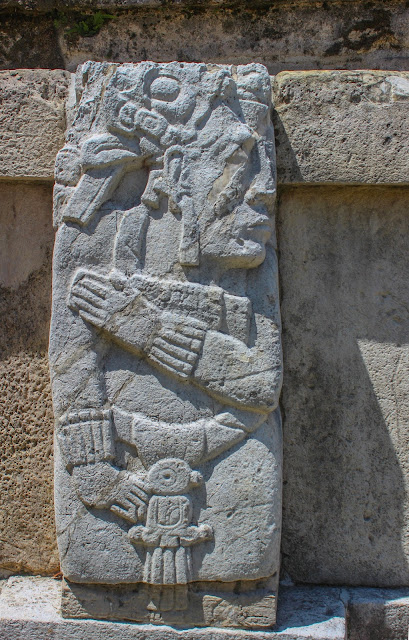The archaeological site of Comalcalco is the westernmost Maya city, 32 miles northwest of Villahermosa in Tabasco State, relatively close to the Gulf of Mexico.
 |
| This map, from the Archaeological Museum in Mexico City, shows Comalcalco to the upper left. Palenque, which we also visited, is southeast of Comalcalco. |
It is the only major Maya city to have buildings constructed of fired clay bricks instead of limestone, due to the lack of limestone in the area. The bricks are irregular and made by cutting varying lengths of clay, as opposed to out of molds. The mortar that held the bricks together was made of calcinated seashells, including oysters.
 |
| This iguana is resting on a series of bricks and mortar. |
 |
| This lizard carved into a clay brick seems fitting. It was in the on-site museum. |
Comalcalco flourished from around 550 CE to 1000 CE when it was abandoned. It was likely involved in the production of cacao and was a trading link between the Gulf Coast and the Yucatan Peninsula.
Temple 1 is a pyramid structure, the first structure to meet our eye and the most dominating structure at the site. It is on the west end of a plaza that stretches out to the east and reminds me of Teotihuacan. The east side of the pyramid has stairs that go 66 feet up, passing through 10 tiers, to the top.
 |
| This re-creation shows Temple 1 at the west end of the plaza. |
 |
| This re-creation is a view from the top of Temple 1 looking east. The Acropolis is to the back right. Temples II and IIa are to the left, Temples III, IIIa and IIIb are to the right, and Temples VIII, VII and VI are behind them, higher up. |
 |
| Temple I to the lest and Temple III to the right as we first walked up. |
Stretching out east of Temple 1 is a plaza with structures on both the north and south side. Temple II is the closest structure to Temple 1 on the north side. We got to it by a fairly steep climb up the side of a hill.
 |
| The top of Temple II. |
 |
| Temple 1 from Temple II. |
On the other side of the plaza, the south side, is Temple III, then Temples IIIa and IIIb stretching to the east.
 |
| Temple III. |
South of the plaza, and up on an artificial hill, is what is called the Great Acropolis which has a palace and some temples. Stretching out to the west is a spur of the Acropolis which has Temples VI, VII and VIII, from east to west. Temple VI is also known as the Temple of the Mask, because a mask of the sun god Kinich Ahau is found in stucco between staircases.
 |
| Looking up at Temples VI, VII and VIII. Judy is going up a walkway to the left. |
 |
| This photo, from the Acropolis, shows Temples VI, VII and VIII in the foreground, Temple 1 to the back left, and Temple II to the right of it. |
 |
| The mask of the sun god in Temple VI. |
The Acropolis is a jumble of buildings which includes a palace and Temple V, and off to the west what I believe is Temple IX on top of the Tomb of the Nine Lords of the Night.
 |
| The Palace to the left and Temple V is center. |
 |
| I believe this is the remains of Temple IX. |
 |
| From the back of the Palace. Temple I is visible at the back and right of center. |
 |
| A view back to the southwest. |
My favorite part of the site was the abundance of
iguanas. I could have spent the entire time looking for them.
The heat, in the high 90s, and humidity, over 90%, were stifling. I was sweating through my clothes. This was my least favorite part of the site.
Maya religion is fairly complex and not something we got much into. There is some animal sacrifice, and even a little human sacrifice. If we get into Maya country again I would like to learn more about the religion.
 |
| This clay figure of a head looks like some of the representations of heads we saw in Palenque. It appears that Palenque may have conquered Comalcalco at some point leading to similarities in architecture. |


















































